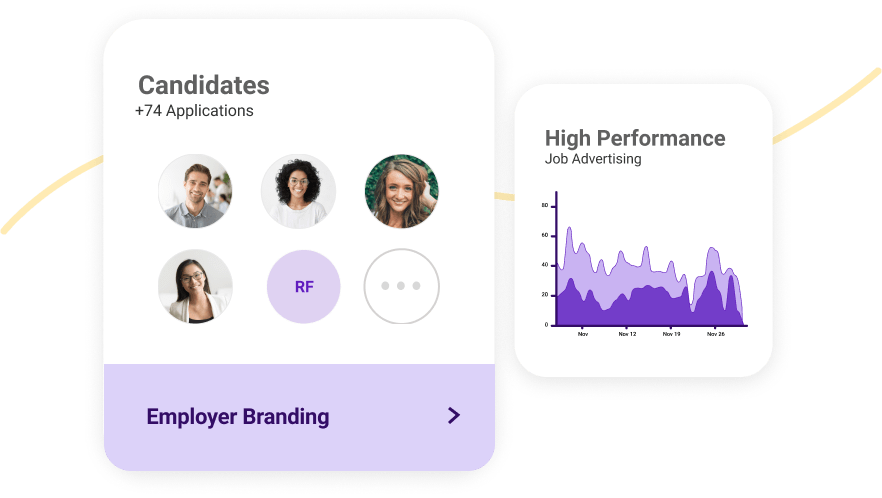Understanding High-Volume Recruiting Metrics
The modern landscape of talent acquisition means understanding metrics – and lots of them.
Recruiters want to know how quickly they can get candidates for a position, how much they’re spending per qualified applicant, and where their candidates are coming from, to name a few. In high-volume recruiting, where the goals are loftier and the timeframes shorter, measurement is crucial.
Which recruiting metrics and KPIs are most important for high-volume professionals to understand?
The “big three” are:
- Source of hire
- Time to fill
- Cost per hire
These are just some of the many recruitment metrics that you should consider. There’s a lot more to metrics than some basic formulas, so we’ll walk you through the top 14 metrics to master.
Sourcing Metrics

Understanding where your applicants come from is a crucial piece of recruiting. The greater your needs, the more important this understanding is.
There are multiple ways to measure and collect sourcing data. You can find applicant sources through your applicant tracking system (ATS) or by using a drop-down question in the application.
Source of hire
The most basic sourcing metric is source of hire. This metric indicates where a hired candidate found and clicked through to the open position you’re offering.
Though a multi-channel recruiting strategy is important to modern day recruiting, not all sources are created equal. Some channels will perform well for certain roles but poorly for others. Some will provide you with a high volume of applicants but not a large pool of qualified ones. It is crucial to understand where your candidates are coming from for each job you offer so you know how to better place your next job ads and allocate your budget accordingly.
Calculate source of hire by dividing your recruiting source yield by the number of applicants from that source. Then, compare the distributions of candidates by source to see which channels are your top performers.
Sourcing channel effectiveness
It’s not only the sources that are getting hires that you should worry about. Stay attentive to how your sources are performing by measuring your sourcing channel effectiveness.
If recruitment ads aren’t doing anything for you or if job boards are carrying most of your recruiting load, there are adjustments to be made. This metric will help you find where.
Identify the number of candidates generated by each channel to draw your comparison. You can also compare the percentage of applications with the percentage of impressions for the position. Consider doing this for qualified candidates as well if you want a measure of quality.
The channels that are most effective should be getting more of your time and budget. Keep your channels open, but don’t waste resources focusing on those that aren’t performing well. Improving your sourcing channel effectiveness is a terrific way to expediate your high-volume recruiting process.
Cost per source
Also known as sourcing channel cost, this is a measure of how much you are spending on each recruiting channel.
When considering how effective each of your sources are at bringing in quality candidates, don’t forget about your budget. Identify how much you are spending per source and compare their performance. Looking at cost per source and sourcing channel effectiveness side by side is an excellent way to spot a misuse of resources.
Sourcing channels that provide the best cost per hire ratio will be the most profitable for your business.
Turnover per source
Turnover is another helpful metric to keep in mind. On its own, it’s a measure of the rate at which you must replace a hired employee with another candidate. If you’re experiencing high turnover, you should find out what about your process is not working for hires.
Turnover per source shows you which source is leading to the most employee turnover. Analyzing this metric may reveal that one of your hiring sources is a less effective recruiting channel than others. Dive into turnover per source by segmenting your hires into source categories, then calculating turnover in each.
This analysis will allow you to identify the channel that, for whatever reason, is allowing for a suffering retention rate. It also shows which channels are providing hires that stick around and are thus effective at providing quality candidates.
How can you improve your sourcing metrics?
A few ways that you can improve your sourcing channel effectiveness, cost per source, and more, are to:
- Use a multi-channel recruiting strategy. Even if some channels are better than others at providing quality candidates, casting a wide net is the best way to reach a large audience.
- Spend more of your recruiting budget on the sources that perform well and less on those that don’t.
- If your turnover per source is high for a channel, consider only using it to promote for urgent or less-skilled roles.
Time Metrics

Timeliness is often a volume recruiter’s highest priority. Short deadlines can make for desperate workers but have no fear – metrics are here.
Time to fill (TTF)
Time to fill (also commonly called time to hire) is the length of time it takes from a candidate applying to getting hired. It is a measure of how fast you are at finding the right candidate and moving them through the job’s pipeline.
Everyone wants this number to be low (a.k.a. fast), but high-volume recruiters have the most at stake. With so many roles to fill and candidates needed to fill them, achieving a low TTF is crucial to hitting hiring goals and maintaining top productivity.
Time to fill isn’t just important on the recruiting side – candidates want a quicker process, too. Reducing the time to hire for a role is a fantastic way to improve candidate experience.
Ultimately, this measures the efficiency of your high-volume recruiting process. This is an overarching metric – diving deeper will reveal where your process is getting slowed down.
Candidate application time
Application time indicates how long it takes a candidate to complete the process of applying for one of your open roles.
It may seem like the least of your concerns to worry about how long it takes a job seeker to fill out your application, but it’s an important thing to watch. The longer your application, the lower your volume of candidates. Plain and simple.
Cut out the painstaking parts of your applications, like having to create an account or manually fill in resume information, to increase the number of applications you see. You could be missing quality candidates due to a lengthy or overly complex application process.
First year attrition
Recruiters know that getting someone hired is only part of the battle. Keeping them on board proves that they were a quality hire in the first place. Retention is an increasingly important part of this field, and this metric helps you keep track.
One way you can measure retention, at least in the early days, is though first year attrition. This is a measure of the number of candidates that leave within their first year of work. Obviously, the goal is to keep this number low.
Tracking first year attrition is a great step toward revealing inadequacies within your recruiting and/or onboarding process. Aim to keep this rate decreasing at your organization over time.
How can you improve your time to fill?
Our recommendations for improving your time to fill for a role:
- Use technology to your advantage. Streamline your redundant tasks by letting HR tools take them on. This will speed the process along and free up your time, too.
- Reduce your application time. This causes more of the people who click on your applications to hit ‘apply.’
- Better understand your target candidate audience through data. Using a tool like Talroo Insights can help you learn what your candidates are looking for.
- Optimize your job postings to ensure the right candidates apply. Improving your volume means improving your timeline.
Discover how Talroo Insights can help improve your time to fill →
Cost Metrics

Sticking to your budget is one of the most difficult parts of high-volume recruiting. With so many applicants needed for every position, it’s crucial to get to those cost-effective strategies.
Watching some key cost metrics will help you meet your budget while still reaching the quality candidates you’re looking for.
Cost per hire
Cost per hire is the amount of money spent on recruiting for one individual hire.
This may be the most important recruiting metric. It spans the entire hiring lifecycle and is a metric that most recruiters, high-volume or not, keeps tabs on.
When you have lots of hires to make, keeping your cost per hire low is especially important, and you can do so by watching and improving other metrics we’ve covered.
To calculate CPH, add up all your recruiting expenses (internal and external) and divide it by the number of hires you received in the same period. Once calculated, this serves as both a goal to stay below and a benchmark for investments in future recruiting cycles.
Return on investment
Return on Investment (ROI) is an efficiency measure of how much value or profit you are getting from money you have spent. Here, it means how much return you’re getting from investing in a strong high-volume recruitment strategy.
Measuring ROI is important in any business function. The recruiting process should not be left out from that discussion.
Many recruiters often struggle to prove a business case to their bosses. Though your role is clearly important to your organization, it can sometimes be difficult to justify spending on necessary things like recruiting tools.
Calculate your high-volume recruiting ROI by segmenting your advertising into campaigns and tracking how many applicants those campaigns generate. Do this with quality applicants and hires, too, to prove the effectiveness of your strategy.
Cost per quality applicant
Like cost per hire, this is a measure of how much you are paying for each applicant that has a high likelihood of turning into a hire.
Many recruitment process outsourcing (RPO) companies boast a high number of applicants they can deliver. But an increased number of applicants doesn’t always mean an increased number of hires. Quality – however you define it – is another huge piece of the puzzle that metrics can help you measure.
Modern recruitment tools typically use a cost per applicant model. We recommend that you take this a step further, at least internally, to track not just how much you’re paying for applicants, but how much you’re paying for quality ones.
How can you improve your recruiting cost metrics?
Follow these to achieve your goal cost per hire, cost per quality applicant, and ROI:
- Automate your processes. Reducing your time to fill will allow your cost per hire to fall along with it.
- Leverage employee referrals and talent pools. These are cost-effective sources that can fill your recruiting pipeline with quality candidates.
- Use social media and your careers page to build a strong employer brand. Though it’s hard to measure the ROI on branding, it’s a long-term strategy that can’t be ignored. Improve your employer brand to increase your application volume.
Other Metrics

To categorize high-volume recruitment metrics into just three boxes – source, time, and cost – is to vastly oversimplify a complex field. There are many metrics that high-volume talent acquisition professionals can and should pay attention to.
Let’s walk through the recruiting journey to list some metrics that could highlight some of the roadblocks you might be hitting.
Candidate conversion ratio
The application completion rate measures how many people complete vs. start your job application process. The click to apply conversion rate measures the ratio of how many people click on your application to how many people apply. Both are conversion metrics that are great measures of candidate experience at the initial touchpoint of the recruiting process.
Modern day recruiters have gotten particularly good at optimizing job ads and applications to better suit job seekers. The click to apply conversion rate and application completion rate are good checks to see if you optimized correctly.
A few reasons why you could have a low application completion rate or a high click to apply rate, are application length, complexity, or lack of mobile-friendliness.
Ratio of interview to hires
The interview to hire ratio shows the average number of candidates that a hiring manager must interview to make an offer on a role.
Breaking your recruiting process down into specific stages of the journey like this allows you to see which pieces of the process need fixing. For most industries, the interview to hire ratio sits at around 4.8:1. A high-volume recruiting best practice is to keep this number closer to 3:1.
Tracking this ratio by role will show you if some jobs are taking up more time and resources than others. It is also an effective way to potentially decrease your time to fill. Interviewing fewer people means a shorter process and an improved candidate experience.
Offer acceptance rate
This is a ratio of job offers accepted to job offers extended. Fittingly, it’s often referred to as the offer to acceptance ratio.
The entire goal of the recruiting process is getting candidates hired. After making it through the application and interview process, they’ll have to receive and accept an offer. And yet, they don’t always do so. Your talent pipeline could be full of quality candidates, but if they’re not accepting roles when offered, there’s a problem.
The offer acceptance rate is a great measure of candidate experience as well as the quality of the end of your hiring process. Some recruiters can analyze this metric on a case-by-case basis, but for high-volume recruiters, it’s more about noticing an overall trend.
If you notice a low ratio, consider improving your candidate experience, shortening the interview to hire timeline, or tweaking the process in some other way. You may even want to send out a feedback form or anonymous survey to candidates who declined offers to see where the problem stems from.
Retention rate
Though not directly part of the recruiting process, this is a hugely important metric to be watchful of. Your goal isn’t just to find and hire top talent, it’s to keep them around.
Retention rate is the measure of how many employees stick around (usually for a given period, like a year). To calculate retention rate, take the number of employees you have on the last day of the period (who stayed on for the year) by the number of employees on the first day.
Conclusion
As you move candidates through your recruiting pipeline, you’ll find that there are improvements to be made at every step. Metrics help you measure the efficiency of your process and can show which variables need tweaking.
Improving your source, time, cost, and other metrics will advance your high-volume recruiting strategy and improve your overall candidate experience.
See more of our high-volume recruiting guide →



